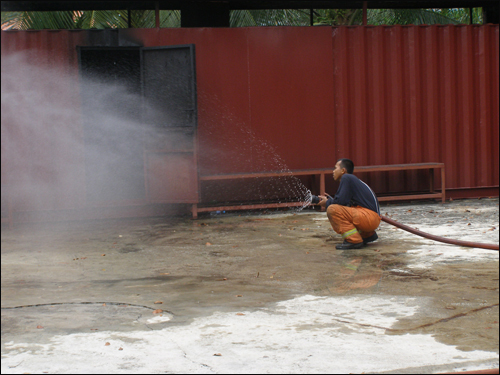Nozzle Techniques & Hose Handling: Part 2
Prior posts in this series, My Nozzle and Basic Nozzle Techniques & Hose Handling, examined the importance of proficiency in use of the firefighters’ primary weapon in offensive firefighting operations.
This is my nozzle, there are many like it but this one is mine. My nozzle is my best friend. It is my life. I must master it as I master my life. Without me it is useless, without my nozzle I am useless.
I will use my nozzle effectively and efficiently to put water where it is needed. I will learn its weaknesses, its strengths, its parts, and its care. I will guard it against damage, keep it clean and ready. This I swear [adapted from the Riflemans Creed, United States Marine Corps].
It is critical that firefighters have both a sound understanding of nozzle performance and skill in the use of their primary weapon. In Figure 1, Assistant Superintendent Mohamed Roslan Bin Zakaria, Bomba dan Penylamat, Malaysia examines stream characteristics from an Akron Turbojet. Note the change in droplet size as the nozzle is closed (droplet size increases as pressure drops). In a short pulse opening and closing the nozzle quickly minimizes production of large droplets that are unlikely to vaporize in the hot gas layer. In long pulses, closing the nozzle slowly increases the percentage of large droplets, but this is a necessary tradeoff to prevent excessive water hammer.
Figure 1. Determining Stream Characteristics

Note: Photo by Shan Raffel, ASFM, CMIFireE, EngTech.
This post continues with a discussion of training methods that can be used to develop proficiency in nozzle techniques and hose handling while deploying hoselines and in compartments having varied configurations. Continuing with our military metaphor, we will be practicing fire and maneuver.
Instructional Concepts
As discussed in Basic Nozzle Techniques and Hose Handling this sequence of drills is designed using the Simplifying Conditions Method (Reigeluth, 1999). This approach moves from simple to complex, beginning with the simplest version of the task that represents the whole and moves to progressively more complex versions until the desired level of complexity is reached. In the case of nozzle technique and hose handling, this involves moving from basic, individual skills, to team skills, and on to integration of physical skills and decision-making.
While modeling a specific technique (such as the short pulse) can be helpful in aiding the learners in developing basic skill, there is a danger. Technique is often mimicked without thought to why it is performed in a particular manner under specific circumstances. Demonstration of a short pulse with a 40o fog pattern (which might be appropriate in a small room) becomes “that is how all short pulses must be performed”. As the learners complete Hose and Nozzle Technique Drills 2 and 3, it is critical to provide changing conditions and encourage the learners to adapt their technique based on conditions.
Drill 2-Hose Handling and Nozzle Operation: Firefighters often lose focus on nozzle technique and operation when they are moving. This drill provides an opportunity for the firefighter with the nozzle and backup firefighter to develop a coordinated approach to movement and operation.
Hose Handling & Nozzle Technique Drill 2 Instructional Plan
Drill 3-Nozzle Operation Inside Compartments: Deployment of hoselines inside a building requires a somewhat different set of skills than simply moving forward and backward. Movement of hoselines around corners and adjustment of nozzle pattern to cool gases in hallways and varied size compartments are important additions to the firefighters’ skill set and provide the next step in developing proficiency in nozzle use.
Hose Handling & Nozzle Technique Drill 3 Instructional Plan
Battle Drills
Analysis of firefighter line-of-duty deaths (LODD) during structural firefighting operations points to the need for highly disciplined, immediate, and appropriate response to rapidly deteriorating conditions. In terms of military small unit tactics, battle drills provide a standardized, collective action rapidly executed without application of a deliberate decision making process (US Army, 1992).
Adapted to firefighting operations, Battle Drills:
- Require minimal leader orders to accomplish and are standard throughout the department
- Are sequential actions vital to success in firefighting operations or critical to preserving life
- Apply to individual companies or teams
- Are trained responses to changing conditions or leader’s orders
- Represent mental steps followed for actions followed in training and firefighting operations
As a starting point for discussing this concept, give some thought to what situations might require a pre-planned and trained set of actions during offensive firefighting operations. For example, this might apply to locating a victim while deploying a hoseline for fire attack, rapidly deteriorating conditions, breathing apparatus malfunction, etc. Also consider how hose handling and nozzle techniques might apply in each of these situations.
Ed Hartin, MS, EFO, MIFireE, CFO
References
Reigeluth, C. (1999). Elaboration theory: Guidance for scope and sequence decisions. In C.M. Reigeluth (Ed.) Instructional-design theories and models: A new paradigm of instructional theory volume II. Mawah, NH: Lawrence Erlbaum Associates.
United States (US) Army. (1992). FM 7-8 Infantry rifle platoon and squad. Washington, DC: Headquarters, Department of the Army
Tags: 3D firefighting, deliberate practice, Fire Behavior Training, Fire Control, nozzle techniques, structural firefighting



November 20th, 2009 at 09:53
[…] Nozzle Techniques & Hose Handling: Part 2 […]
November 20th, 2009 at 11:41
hello Ed,
i translated the drill number 2 for my blog,not the whole article.
tcare.
December 15th, 2009 at 08:06
[…] Nozzle Techniques & Hose Handling: Part 2 […]